Invented by James R. Baker, Jr., Tarek Hamouda, Amy Shih, Andrzej Myc, University of Michigan
Nontoxic antimicrobial compositions are made from natural ingredients that are safe for humans and the environment. They are effective at killing bacteria, viruses, and other harmful microorganisms, without the use of harsh chemicals. These products are becoming increasingly popular in a variety of industries, including healthcare, food processing, and consumer goods.
One of the biggest drivers of the market for nontoxic antimicrobial compositions is the growing concern over antibiotic resistance. Traditional antimicrobial products contain antibiotics that can contribute to the development of antibiotic-resistant bacteria. This is a serious public health concern, as antibiotic-resistant infections are becoming more common and more difficult to treat.
Nontoxic antimicrobial compositions offer a safer alternative to traditional antimicrobial products. They are effective at killing harmful microorganisms without contributing to antibiotic resistance. This makes them an attractive option for healthcare facilities, where preventing the spread of infection is a top priority.
Another driver of the market for nontoxic antimicrobial compositions is the increasing demand for natural and organic products. Consumers are becoming more aware of the potential health and environmental risks associated with traditional antimicrobial products, and they are looking for safer alternatives. Nontoxic antimicrobial compositions offer a natural and organic solution that is safe for humans and the environment.
The market for nontoxic antimicrobial compositions is expected to continue to grow in the coming years. As consumers become more aware of the dangers of traditional antimicrobial products, they will increasingly turn to safer alternatives. This presents an opportunity for companies that are developing nontoxic antimicrobial compositions to capitalize on this growing demand.
In conclusion, the market for nontoxic antimicrobial compositions is growing rapidly as consumers become more aware of the dangers of traditional antimicrobial products. These products offer a safer alternative that is effective at killing harmful microorganisms without the use of harsh chemicals. As the demand for natural and organic products continues to grow, the market for nontoxic antimicrobial compositions is expected to continue to expand in the coming years.
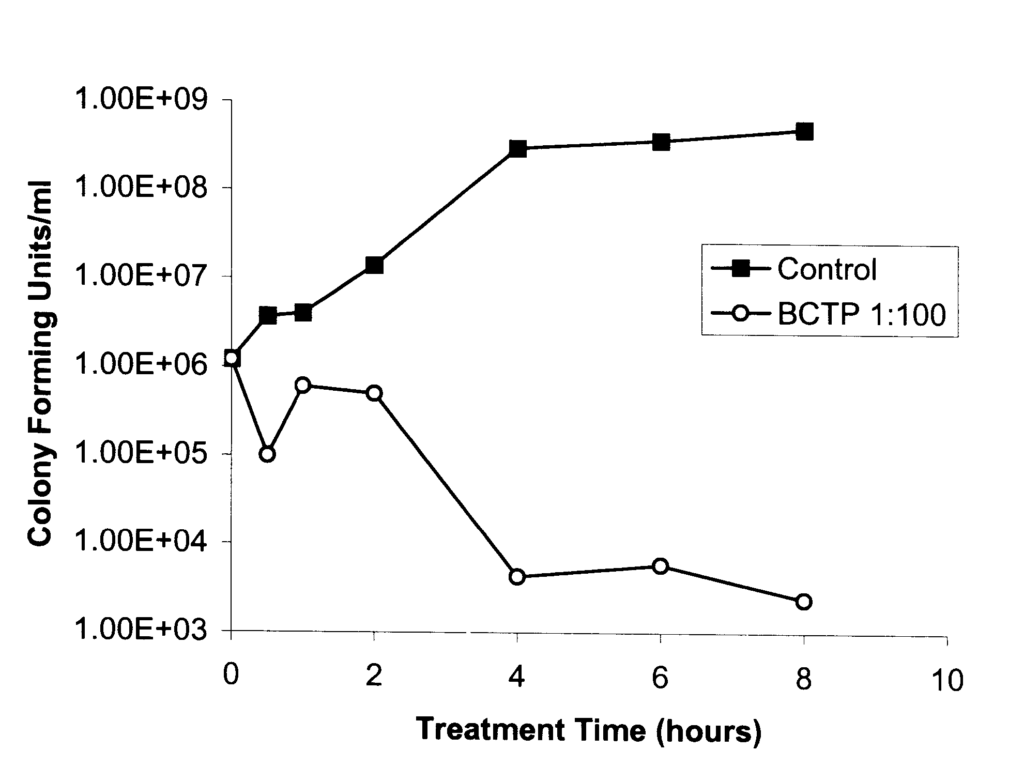
The University of Michigan invention works as follows
The present invention is concerned with compositions and techniques for reducing the infectivity and morbidity of various pathogenic organisms, as well as the rate of mortality. The invention also includes compositions and methods for decontaminating infected or colonized areas. The present invention also relates to compositions and methods for decreasing the infectivity in foodstuffs of pathogenic bacteria.
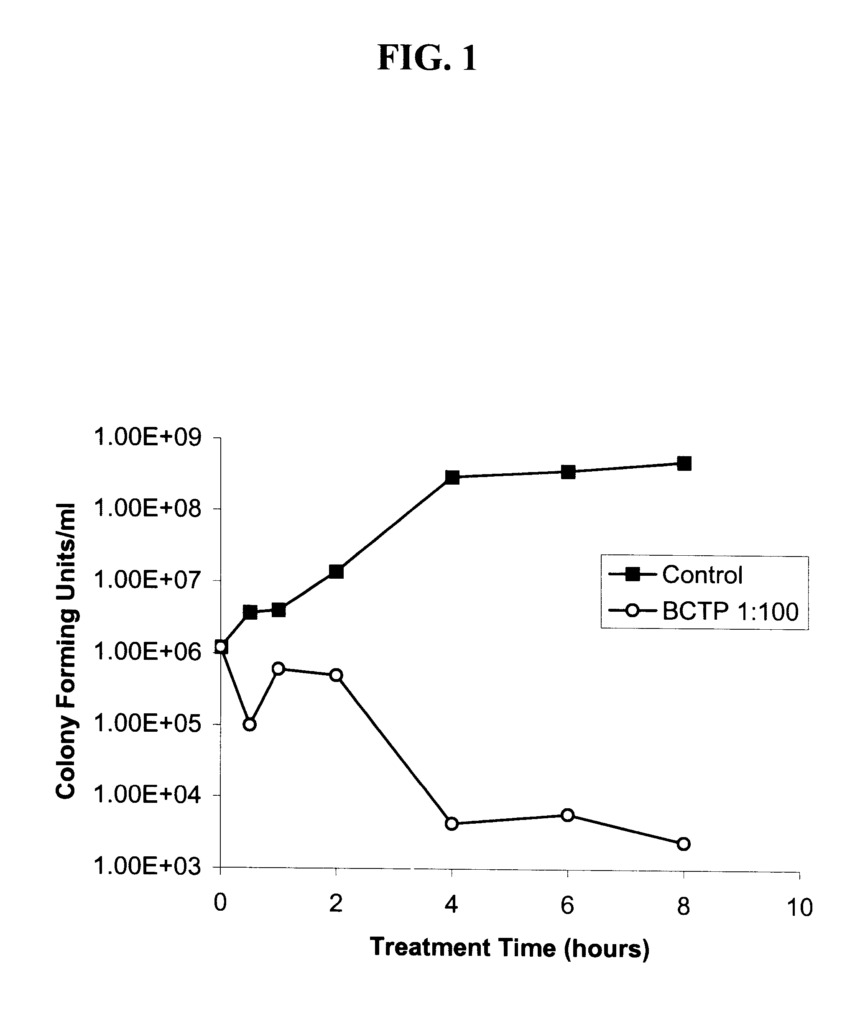
Background for Nontoxic antimicrobial compositions
Pathogens like bacteria, fungi and viruses are responsible for many human and animal illnesses, as well contamination of food, biological samples and the environment. Infections caused by microbes in animals begin with the attachment of or colonization on skin or mucous membranes. This is followed by invasion and spread of the infectious organism. “The skin and mucous membranes are the main entry points for pathogenic bacteria.
Bacillus bacteria, in particular, form stable spores which can withstand harsh conditions and extreme temperature. B. anthracis contamination of farmlands can cause a deadly disease to domestic, agricultural and wild animals. (See, e.g. Dragon and Rennie. Vet. J. 36:295 [1995]). Contact with infected animals and infected products can lead to human infection. (See, e.g. Welkos et.al., Infect. Immun. 51:795 [1986]). A pulmonary syndrome is a common human clinical syndrome that can be fatal and has a rapid start. Although less severe, the gastrointestinal and skin forms of anthrax can still be fatal if not treated aggressively. (See, e.g. Franz et.al., JAMA 278, 399 [1997] and Pile, et.al., Arch. Intem. Med. 158:429 [1998]). Human Bacillus Anthracis infections are rare due to the use of effective animal control measures, such as vaccines, anti-biotics and proper disposal of infected animals. Animal anthrax is still a problem because it’s difficult to decontaminate land and farms. There is also concern over human infection caused by war and/or terrorist activity.
Mobley, Military Med. 160:547 [1995]). Bacillus Anthracis accidentally released from a military laboratory in the Soviet Union demonstrated the potential dangers of using Anthrax as a weapon. The accident was responsible for 67 cases of anthrax in humans, including 66 fatalities. Some anthrax cases occurred up to 4 km from the lab (See, e.g. Meselson and al., Science 266, 1202 [1994]). Infected patients were genetically analyzed to determine whether they had multiple strains of B. anthracis or a genetically modified B.anthracis. (See, e.g. Jackson et.al., Proceedings of the National Academy of Sciences, 266:1202 [1994]). Nat. Acad. Acad. U.S.A. 95:1224 [1998]).
Also, other members from the Bacillus family are reported as etiological agents of many human diseases. Bacillus cereus, a common pathogen, is involved in many diseases. The ability of its spores survive cooking is a factor in the development of food-borne illnesses. Also, it is associated with systemic and local infection, including sepsis (See, e.g. Drobniewski’s Clinical Infection). Micro. Rev. 6:324 [1993]). Many bacteria are resistant to antibiotics. “An organism that is infected by an antibiotic-resistant strain has serious and potentially fatal consequences.
Salmonella, E. coli, and Enterococci are all bacteria that can develop resistance. They cause diarrhea, bloodstream infections, surgical wounds, and urinary tract infection. al., J. Infcet. Dis. 170(2):272 [1994]).
Although a valuable advance, antimicrobial and antibiotic therapy has several problems. This is especially true when resistant strains of bacteria are discovered. In addition, disinfectants/biocides (e.g., sodium hypochlorite, formaldehyde and phenols) that are highly effective against Bacillus spores, are not well suited for decontamination of the environment, equipment, or casualties. The reason for this is that the volatile fumes are toxic and can cause severe lung injury or tissue necrosis. These compounds are also corrosive, making them unsuitable to decontaminate sensitive equipment. (See, e.g. Alasri and al., Can. J. Micro. 39:52 [1993]; Beauchamp et al., Crit. Rev. Tox. 22:143 [1992]; Hess et al., Amer. J. dent. 4:51 [1991]; Lineaweaver et al., Arch. Surg. 120:267 [1985]; Morgan, Tox. Path. Path. Micro. 3;99 [1990]).
Influenza virus is a common respiratory pathogen, which is widely used to test antiviral agents in vitro. (See, e.g. Karaivanova and Spiro Biochem. J. 329:511 [1998]; Mammen et al., J. Med. Chem. Chem. Agents Chemother. 42:640 [1998] and Smith et. al., J. Med. Chem. 41:787 [1998]). The envelope glycoproteins hemagglutinin and neuraminidase, which determine antigenic specificity, can easily mutate. This allows the virus to evade the neutralizing antibodies. Anti-viral drugs and neuraminidase inhibitors are only minimally effective, and viral resistance is widespread.
It is evident that antipathogenic compositions or methods are required to reduce the infectivity and morbidity and mortality of pathogenic exposure. These compositions and methods must ideally not promote microbial resistant or be toxic to recipients.
The present invention is concerned with compositions and techniques for reducing the infectivity of pathogens, their morbidity and mortality rates. The present invention also pertains to compositions and methods for decontaminating food, foodstuffs, or areas that have been colonized by microorganisms or pathogens. Certain embodiments are nontoxic, and can be safely consumed by humans or other animals. Moreover, certain embodiments are chemically stable as well as non-staining.
In some embodiments of the invention, compositions and treatments are provided for animals, such as humans, who have been exposed to pathogens. In certain embodiments, animals are contacted with the compositions in effective amounts prior to being exposed to pathogenic organisms. In some embodiments, animals are contacted with the compositions in effective amounts after being exposed to pathogenic organisms. The present invention is therefore applicable to both prevention and treatment.
In other embodiments of the invention, compositions and decontamination methods are provided for organic and inorganic surfaces that have been exposed to pathogens. In other embodiments, the compositions can be used to inhibit the growth of microorganisms that are harmful or undesirable in biological samples and environmental samples.
In preferred embodiments, the infectivity of pathogenic bacteria, their morbidity and mortality are reduced by contacting them with an oil-in water nanoemulsion containing an oil phase and an aqueous component. In certain preferred embodiments, an emulsion also comprises a solution. In certain preferred embodiments, a solvent based on organic phosphate is used. In other embodiments the organic phosphate based solvent includes dialkyl or trialkyl (e.g. tributyl) phosphates. In other preferred embodiments the emulsion also comprises alcohol. The solvent in preferred embodiments which use solvents is present in the oil phase.
In some embodiments the compositions of this invention also comprise one or more detergents or surfactants. In certain embodiments, the surfactant can be a non-anionic cleaner. In preferred embodiments the non-anionic surfactant is a polysorbate. In other embodiments the non-anionic cleaner is a polyoxyethyleneether. The present invention uses surfactants from the TWEEN family, TRITON family, and TYLOXAPOL family of compounds.
In certain other embodiments the compositions of this invention also contain one or more cationic, halogen-containing compounds including, but not limited, to cetylpyridinium chloride. In other embodiments the compositions of this invention also contain one or more compounds which promote or enhance germination. Certain microorganisms, in particular spores of certain bacteria, are capable of germination. Germination enhancers that are contemplated to be formulated with the inventive compositions, include but are not restricted to L-alanine Inosine CaCl2 and NH4Cl. In yet further embodiments, compositions of the invention also contain one or more compounds which increase interaction (?interaction promoters?) of the composition with microorganisms (e.g., chelating agents like ethylenediaminetetraacetic acid, or ethylenebis(oxyethylenenitrilo)tetraacetic acid in a buffer). In other embodiments, the formulations also include coloring or flavoring agent (e.g. dyes, peppermint oil).
In some embodiments, a composition may also include an emulsifying component to help form emulsions. Emulsifying compounds are those that aggregate at the interface of oil and water to form a continuous membrane, preventing direct contact between adjacent droplets. Some embodiments of the invention include oil-in water emulsions that can be easily diluted with a desired amount of water without affecting their anti-pathogenic qualities.
Oil-in-water Emulsions may also contain other lipids, including micelles, small clusters of amphiphilic molecules, or lamellar phase (lipid dispersions that are composed of parallel bilayers with polar heads facing outward towards the aqueous layer and apolar tails sequestered away from it).
These lipid structures form as a result hydrophobic forces which drive apolar residues away from the water (e.g. long hydrocarbon chains). These lipids preparations are generally known as surfactant-lipid preparations (SLPs). SLPs have a low toxicity to mucous surfaces and are thought to be metabolized in the small intestine. (See, e.g. Hamouda, et.al., J. Infect. Disease 180:1939 (1998)). SLPs do not corrode metals or plastics, unlike disinfectants like bleach. SLPs can be used to create formulations that are particularly effective against bacteria, fungi and viruses.
Certain embodiments of the invention envisage methods for reducing the infectivity microorganisms, e.g. pathogenic agents. These include contacting the pathogens with a composition containing an oil-in water emulsion. In certain preferred embodiments, an oil phase is distributed in an water phase with a detergent, and the oil phase contains an organic phosphate-based solvent. In some embodiments two or more distinct types of emulsion are exposed to the bacteria. In preferred embodiments the emulsions used are fusigenic or lysogenic. The oil phase of the method is preferably a non-phosphate solvent (e.g. an alcohol).
In certain embodiments, contacting occurs for a sufficient time to kill or inhibit the growth the agent. In other embodiments of the invention, a method is provided for decontaminating a surface that harbors harmful or unwanted pathogens. In one embodiment, a pathogenic agent is attached to an environmental surface. The method involves contacting the surface with a sufficient amount of composition for decontaminating it. Decontamination does not necessarily mean that the pathogen is completely eliminated, even if this is desired. The compositions and methods may also include dyes, paints or other marking and identifying compounds in some embodiments to verify that the surface has been adequately treated by the compositions.
In certain embodiments, a composition according to the present invention is administered internally to an animal. In certain preferred embodiments, contacting occurs via intradermal injection, subcutaneous injection, intramuscular injection, or intraperitoneal inject. In other embodiments the contacting can be done via nasal, buccal or vaginal administration. The compositions may also contain pharmaceutically acceptable adjutants and excipients. In yet further embodiments of the invention, compositions may also include pharmaceutically acceptable bioactive molecule (e.g. antibodies, antibiotics or means for nucleic acids transfection. Vitamins, minerals, cofactors etc .).
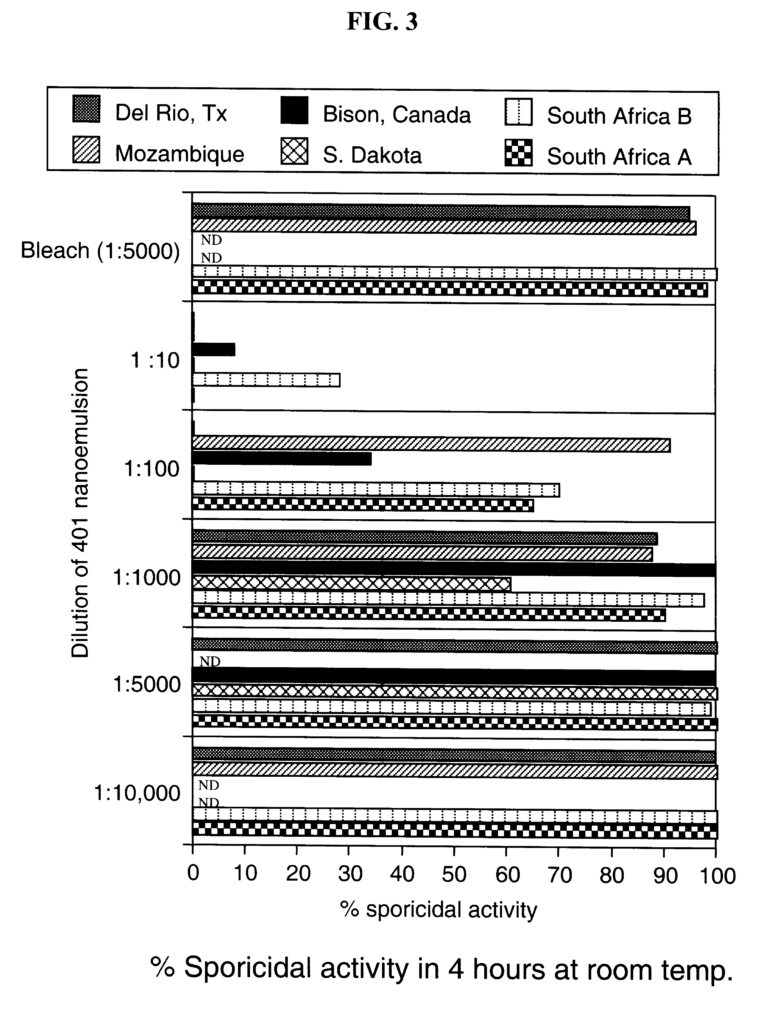
The present invention, in some preferred embodiments provides a composition that comprises an oil-inwater emulsion. This oil-inwater emulsion includes a discontinuous liquid phase dispersed within an aqueous solution, with a first component of alcohol or glycerol and a second ingredient comprising either a surfactant, or a compound containing halogens. The aqueous solution can be any type of water (e.g. diH2O), distilled water or tap water. It also includes solutions (e.g. phosphate-buffer saline) as well. Oil phase can include any oil type, including but not limited, to plant oils, animal oils, flavor oils, water-insoluble vitamins, mineral oils, motor oils, canola, corn, rapeseed, sunflower, and avocado oils, as well as squalene, olive, canola, corn, safflower, and cottonseed oils. In some preferred embodiments the oil phase is 30 to 90 vol % (i.e. represents 30 to 90% of the total volume in the final emulsion). More preferably, it is 50 to 80%. The present invention is not limited to the type of alcohol, but in some preferred embodiments the alcohol is either ethanol or methane. Furthermore, while the present invention is not limited by the nature of the surfactant, in some preferred embodiments, the surfactant is a polysorbate surfactant (e.g., TWEEN 20, TWEEN 40, TWEEN 60, and TWEEN 80), a pheoxypolyethoxyethanol (e.g., TRITON X-100, X-301, X-165, X-102, and X-200, and TYLOXAPOL) or sodium dodecyl sulfate. Likewise, while the present invention is not limited by the nature of the halogen-containing compound, in some preferred embodiments, the halogen-containing compound comprises a cetylpyridinium halides, cetyltrimethylammonium halides, cetyldimethylethylammonium halides, cetyldimethylbenzylammonium halides, cetyltributylphosphonium halides, dodecyltrimethylammonium halides, tetradecyltrimethylammonium halides, cetylpyridinium chloride, cetyltrimethylammonium chloride, cetylbenzyldimethylammonium chloride, cetylpyridinium bromide, cetyltrimethylammonium bromide, cetyidimethylethylammonium bromide, cetyltributylphosphonium bromide, dodecyltrimethylammonium bromide, or tetrad ecyltrimethylammonium bromide.
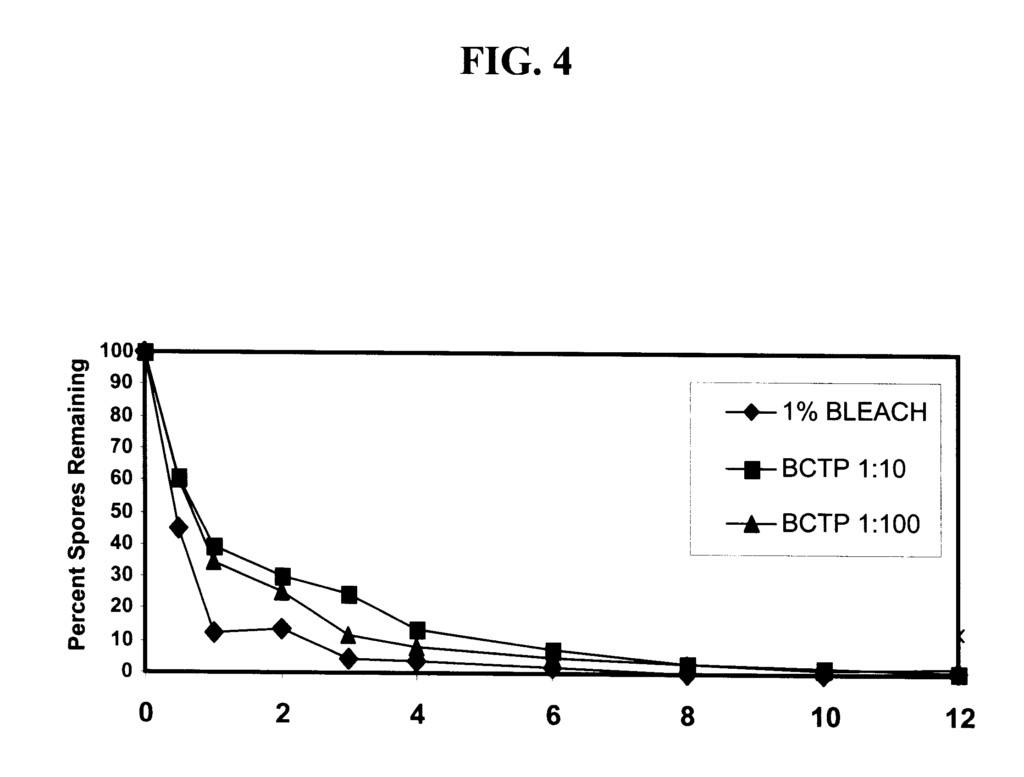
Click here to view the patent on Google Patents.
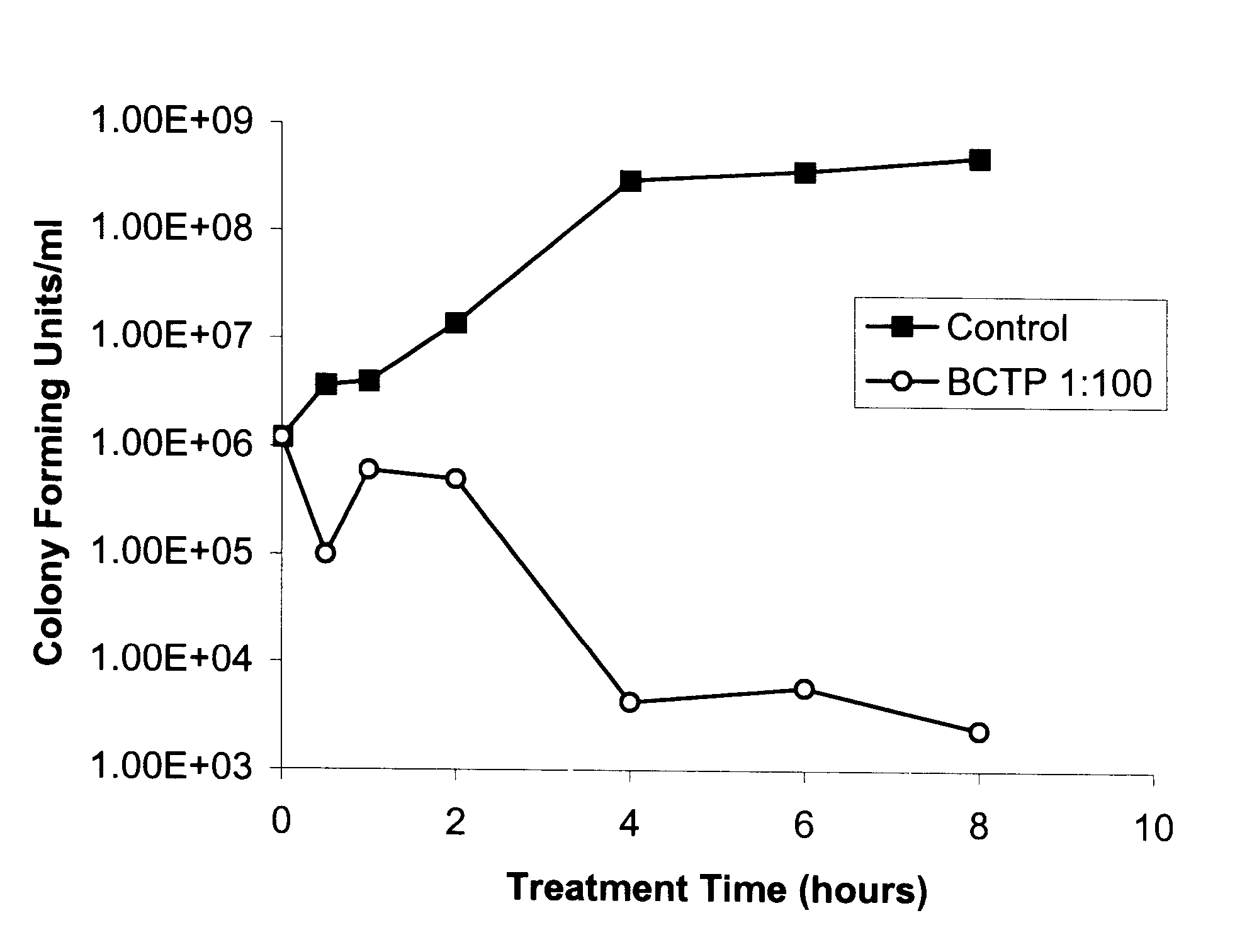
Leave a Reply